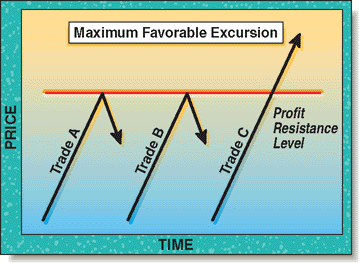Maximum favorable excursion (MFE), a concept originally created by John Sweeney to measure the distinctive characteristics of profitable trades, can be used as part of an analytical process to enable traders to distinguish between average trades and those that offer substantially greater profit potential. Using MFE analysis, traders can classify above-average performance during a trade and thereby recognize opportunities to enhance profitability with the MFE risk management strategy.
SYSTEM DESIGN
The Maximum Favorable Excursion Strategy
by David C. Stendahl and Leo J. Zamansky
Maximum favorable excursion (MFE) is the peak profit that a trade earns before the trade is closed out. Reviewing the performance of a trading system allows us to measure the tendency of the MFE of the trades. This article explains how to use the information to enhance profitability.

Following the strategy, traders can increase profit potential relative to risk by adding to positions based on the trading characteristics of a system. This strategy can be used with all systems, whether they are mechanized, discretionary, long, short, intraday, or end of day. The returns of the system must, however, exhibit certain characteristics to take advantage of this risk management strategy.FIGURE 1: PROFIT/LOSS VERSUS TIME. Trades A and B fail to penetrate the profit resistance level. Trade C, however, breaks through. This profit implies a stronger momentum surge than the other trades.
Since every trading methodology is different, it will take a thorough performance evaluation to determine if the MFE strategy is suitable for the system.
APPLYING MFE STRATEGY
The objective of the MFE strategy is to add to positions during trades that offer greater than normal profit potential. With this in mind, the first step is to determine whether the trading system exhibits exploitable MFE characteristics. The second step is to determine the point at which to add to positions. The third and final step in using the MFE strategy is to reevaluate the systemÕs performance after applying the strategy to ensure that the risk-reward characteristics remain intact.
Before we examine the analysis itself, let's walk through some key concepts. To better explain MFE, consider the notion of support and resistance as applied to price charts.
A tenet of basic technical analysis is if the price action of a security penetrates and remains above a specific resistance level, that resistance level becomes a support level for the security. While this is a generalization, these support levels do typically hold the security for a period before new market conditions take control.
The same concept of support and resistance can be applied to the price behavior of a security during the life of the trade. Once an open profit has penetrated a specific percentage level, the trade typically remains above the support level for the duration.
Figure 1 illustrates this support and resistance concept in terms of three individual trades. Trades A and B fail to penetrate the profit resistance level. Trade C, however, breaks through, implying a stronger momentum surge than the other trades. The goal of the MFE strategy is to identify this resistance level and add to positions at a specific support/resistance level to improve the system's total performance.